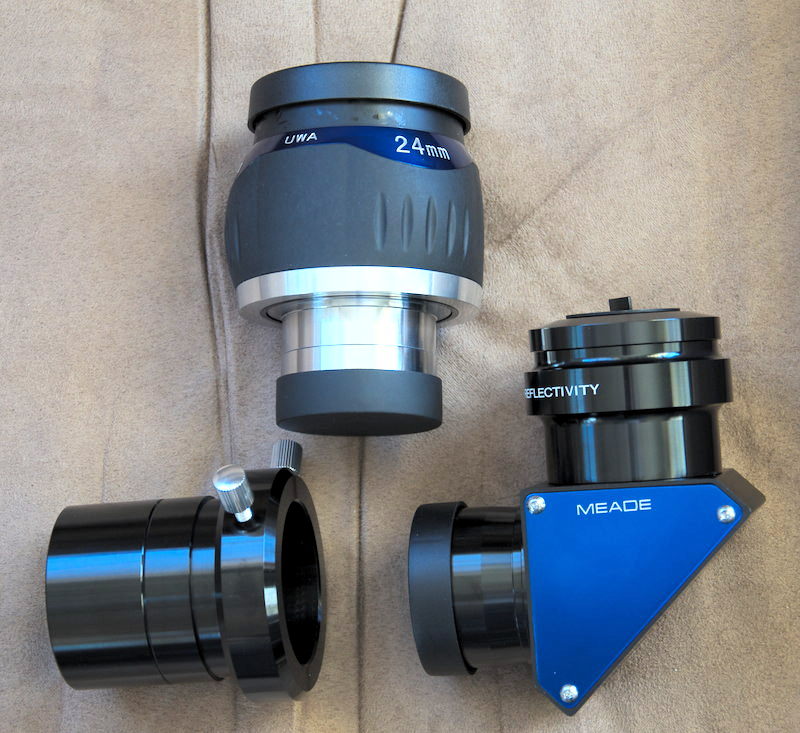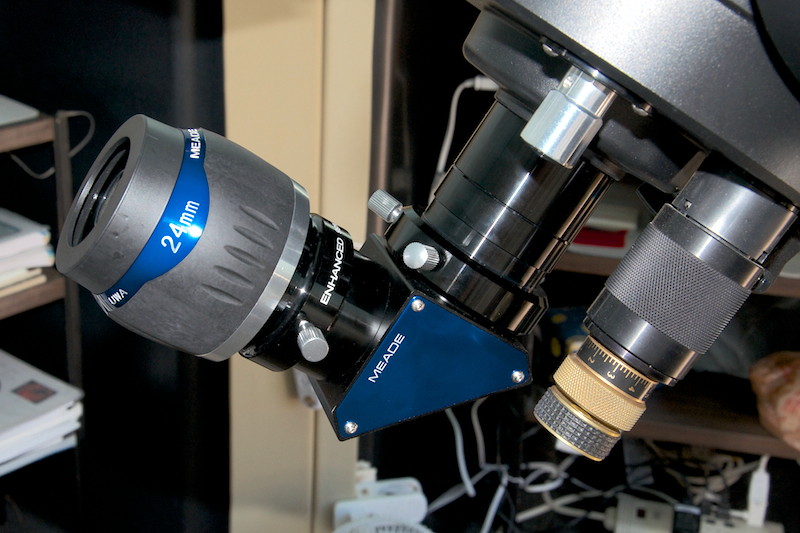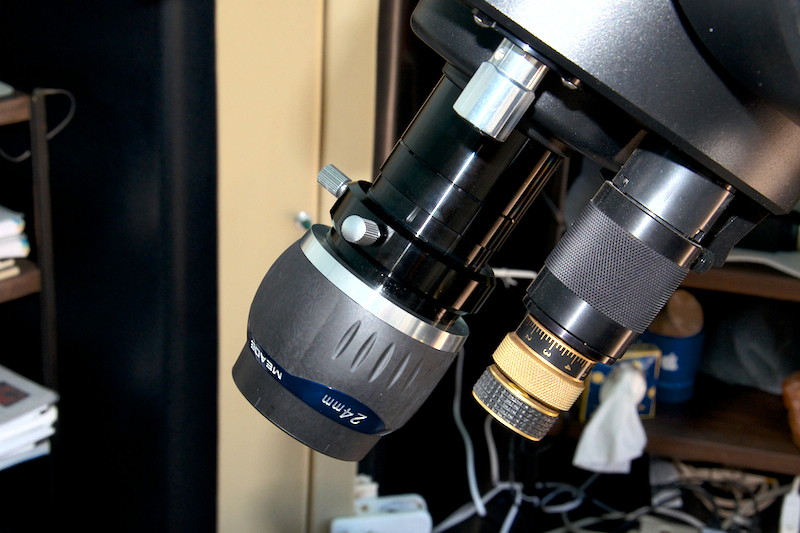
Review: Meade 2" 99% Reflectivity Mirror Diagonal
& 24mm Ultra-Wide Angle (UWA) Eyepiece Kit
Posted: 14 April 2013
A recent posting on the LX200GPS Yahoo Group mentioned that Woodland Hills Camera & Telescopes had a special deal on the Meade 2" 99% Reflectivity Mirror Diagonal and 24mm Ultra-Wide Angle (UWA) Eyepiece Kit ($159, although price has now been raised to $189; list price $398). Dr. Clay Sherrod had this to say on the Group:
I can tell you without hesitation that the 24mm UWA eyepiece is the best kept secret in the astronomy business. Several of us have spent hours testing this eyepiece against Naglers, Panoptics, the supposedly "100 deg" eyepieces on the market and without a doubt, this eyepiece outperforms them all.
Get them while you can. I honestly do not know how this eyepiece has remained hidden from reviews for as long as it has.
It weighs about the same as two hand grenades, so it is a big chunk of metal and glass.....
Worth every penny times three.
Dr. Clay
_____
Arkansas Sky Observatories
MPC H45 - Petit Jean Mountain South
MPC H41 - Petit Jean Mountain
MPC H43 - Conway West
http://www.arksky.org/
I placed my order on 29 March, and it arrived on 5 April:

The photo above shows the 2" eyepiece, a 2" visual back, and the 2" diagonal. The diagonal includes an adapter that allows 1.25" diameter eyepieces to be used. The adapter can also be used directly on the visual back. The diagonal and eyepiece have threads to accept 2" filters, but I have no 2" filters to test. Here is the 2" diagonal and 2" 24mm UWA eyepiece on my 8" LX200-ACF:

This is the 2" eyepiece using just the visual back:

Due to cloudy skies and the need to complete some other activities, my initial use was delayed. On Thursday, 11 April 2013, although it was a cloudy night, I was able to do field-of-view (FOV) measurements of all my eyepieces and D7000 DSLR using the visual back with and without the star diagonal. All my 1.25" and 2" eyepieces focused using the visual back, with and without the star diagonal, and with and without the Antares f/6.3 focal reducer. The D7000 DSLR was able to focus in every mode except when using the focal reducer with the star diagonal. These were the general results, comparing the Meade diagonal and 2" visual back to the OPT star diagonal and Meade 1.25" visual back:
FOV with Meade diagonal slightly smaller with all eyepieces and camera than with the OPT diagonal.
FOV with Meade diagonal + focal reducer larger than with the OPT diagonal + focal reducer.
FOV with Meade 2" visual back slightly smaller than with a Meade 1.25" visual back.
FOV with Meade 2" visual back + focal reducer slightly larger than with a Meade 1.25" visual back + focal reducer.
The FOV of the 2" 24mm UWA eyepiece was:
Meade diagonal: 54'09"
OPT diagonal: 55'11"
Meade 2" visual back: 01°02'51"
Meade 2" visual back + focal reducer: 01°22'27"
OPT diagonal + focal reducer: 01°44'05"
Meade diagonal + focal reducer: 02°02'25"
The observatory was opened on Saturday, 13 April 2013, at 1811 MST, 85°F. There were some clouds in the sky and there was a breeze blowing. This night was strictly an observing night to test of the new diagonal and eyepiece, with some comparisons to the OPT diagonal and some other eyepieces.
My first visual test of the Meade diagonal and 2" 24mm UWA eyepiece was on the crescent moon about 10 minutes before sunset. The entire lunar disk was easily seen within the FOV and the view was sharp all the way to the edge of the FOV. I switched to the OPT diagonal + 1.25" Meade Series 5000 26mm eyepiece; the view was similar but the view at the FOV edge was not as sharp. The view using the 2" 24mm eyepiece on the OPT diagonal was similar to the Meade diagonal. but not as sharp at the edge. With the 1.25" 26mm eyepiece on the Meade diagonal there was definitely a smaller FOV but the view was sharp to the edge. I did test comparisons of the two diagonals using a 1.25" Meade Series 5000 5.5mm eyepiece. The view was similar using either diagonal. I then used my Explore Scientific 2" 9mm 100° eyepiece on both diagonals to view the moon and Jupiter. Using the Meade diagonal, the 9mm and 24mm eyepieces were nearly parfocal. To my eye the Meade diagonal + visual back and the OPT diagonal (which doesn't need a visual back) were very similar with the eyepieces tested, with the Meade diagonal providing slightly better sharpness over the entire FOV.
I also viewed M42, the Great Nebula in Orion using the Meade diagonal and 2" 24mm eyepiece. When I first started viewing M42, the sky was still somewhat bright and no nebulosity was visible. However, the stars in the FOV were crisp pinpoints almost all the way to the edge of the FOV. With the 1.25" 26mm eyepiece, the stars were less crisp. All six stars in the Trapezium were easier to see with the 2" 24mm eyepiece than with the 1.25" 26mm eyepiece. As the sky darkened, the nebula became visible and was well within the FOV of the 2" 24mm UWA eyepiece.
I attached the Antares f/6.3 focal reducer and used the Meade diagonal and 2" 24mm UWA eyepiece to view M42. Wow, what a tremendous view! Details in the nebula were visible along with many stars in this very wide angle view. The stars were surprisingly sharp all the way to the edge of the wide FOV. Next, I viewed the Leo Triplet of Galaxies (M65, M66, NGC3628); all were well within the FOV with the focal reducer and 24mm eyepiece. I removed the focal reducer and all three galaxies were still easily viewable in the same FOV. I viewed the Triplet using the OPT diagonal + 1.25" 26mm eyepiece; the three galaxies were just barely in the same FOV. Using the OPT diagonal + 2" 24mm eyepiece, all three galaxies were easily seen in the same FOV.
I also viewed M51, the Whirlpool Galaxy, using both diagonals with the 2" 24mm and 1.25" 26mm eyepieces. Other than the wider FOV with the 24mm UWA eyepiece, there was not much difference in the views. But that wide FOV provides more context when viewing faint objects since you can see more stars surrounding the object you are looking at.
By 2034 MST, clouds were in most of the sky, forcing an end to the session. The observatory was closed at 2056 MST, 63°F.
If you don't already have a 2" star diagonal, then either the Meade 2" diagonal or the OPT 2" diagonal are excellent choices to move up to using 2" eyepieces. The weight of the Meade diagonal + visual back is about the same as the OPT diagonal (no visual back needed).
If you use a 1.25" 26mm eyepiece (or similar) and want to move to a 2" eyepiece that provides a similar magnification, the Meade 2" 24mm Ultra-Wide Angle Eyepiece should be that choice and will provide a wider field-of-view as well. The 2" 24mm UWA eyepiece IS heavy, but I found that it was not too heavy for use on my wedge mounted 8".
Unlike the OPT diagonal, which is a one piece unit that screws onto the SCT port, the Meade diagonal requires the use a 2" visual back, and therefore it is a two-step operation to remove it when adding a focal reducer or when switching to imaging using the off-axis guider. First, you remove the diagonal from the visual back by loosening the two screws. Then you unscrew the visual back. Re-attaching the diagonal is the same two-step operation, only reversed. But since the Meade 2" diagonal is supplied with a 2" visual back, you get the benefit of being able to use a 2" visual back to view straight-through when needed.
The Meade diagonal is held in the visual back using two screws on the visual back. Unlike the tube on many modern eyepieces (including the 2" 24mm UWA eyepiece), there is no indentation on the diagonal tube to keep the diagonal from slipping out should the screws loosen. To me, that isn't as secure as the OPT diagonal, which screws onto the SCT port as a single unit. When I finished a session with the telescope, the OPT diagonal always remained on the telescope with the Meade Series 5000 26mm attached. With the seemingly less secure Meade diagonal, I have changed how I operate since I am worried that the screws could loosen due to temperature variations (which may or may not be likely) and let the diagonal fall to the observatory floor. I will now remove the diagonal and visual back from the telescope and cover the SCT port with its screw-on cap at the end of each session. This increases the time somewhat to start using the telescope as I now have to re-attach the visual back, diagonal, and eyepiece.
I have switched from using the OPT diagonal to the Meade diagonal since I get the benefit of having a 2" visual back. And with the Meade 2" 24mm UWA eyepiece (83X, FOV 54'09") providing a better view than the 1.25" Meade Series 5000 26mm eyepiece (77X, FOV 41'42"), it has become my main startup and medium power eyepiece for the 8" LX200-ACF. I now have a wide range of 2" eyepieces from 50mm to 9mm, making me closer to a complete switch to 2" eyepieces for observing. I still expect to use my 1.25" Meade Series 5000 5.5mm, 1.25" Meade 3X TeleXtender, and 1.25" Meade 2X Barlow Lens when I need and can use higher magnifications. Someday, I hope to acquire a 2" eyepiece in the 5-6mm range.
Bottom line: I am really going to enjoy using the Meade 2" 24mm Ultra-Wide Angle Eyepiece with the Meade 2" diagonal and visual back at Cassiopeia Observatory.
Comments are welcome; use the Comments section below, or you can Email Me. Thanks.
Go to the previous report.
Return to the Cassiopeia Observatory Home Page.